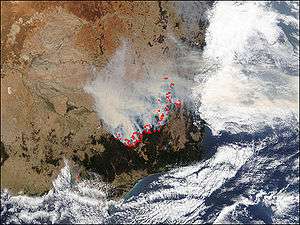2003 Eastern Victorian alpine bushfires


The Eastern Victorian alpine bushfires, started with eighty seven fires that were started by lightning in the north east of Victoria on 8 January 2003. Eight of these fires were unable to be contained and joined together to form the largest fire in Victoria since the 1939 "Black Friday" bushfires.[1]
The main fire burnt over 13,000 km² over 59 days before it was contained on 7 March 2003. 41 homes were destroyed and over 9,000 livestock killed. Thousands of kilometres of fencing was also destroyed. This was the longest running fire until the 2006-07 Great Divide fires.
In early February, at the peak of the fires, around 3,760 people were involved in the fire effort, excluding local CFA brigades. This figure includes 160 Defence Force staff, over 300 interstate firefighters, 33 alpine firefighting specialists from New Zealand and 35 personnel from the United States. In total, 15,725 personnel were directly engaged on fighting these bushfires.
The areas affected included, Mount Buffalo, Mount Bogong, Mount Feathertop, Bright, Dinner Plain, Benambra, Omeo, Cobungra, Shannonvale, Bundara, Anglers Rest, Sunnyside, Glen Wills, and Dargo.
See also
References
- ↑ Major Bushfires in Victoria Archived 22 March 2012 at the Wayback Machine., Department of Sustainability and Environment
| Wikimedia Commons has media related to 2003 Victorian bushfires. |